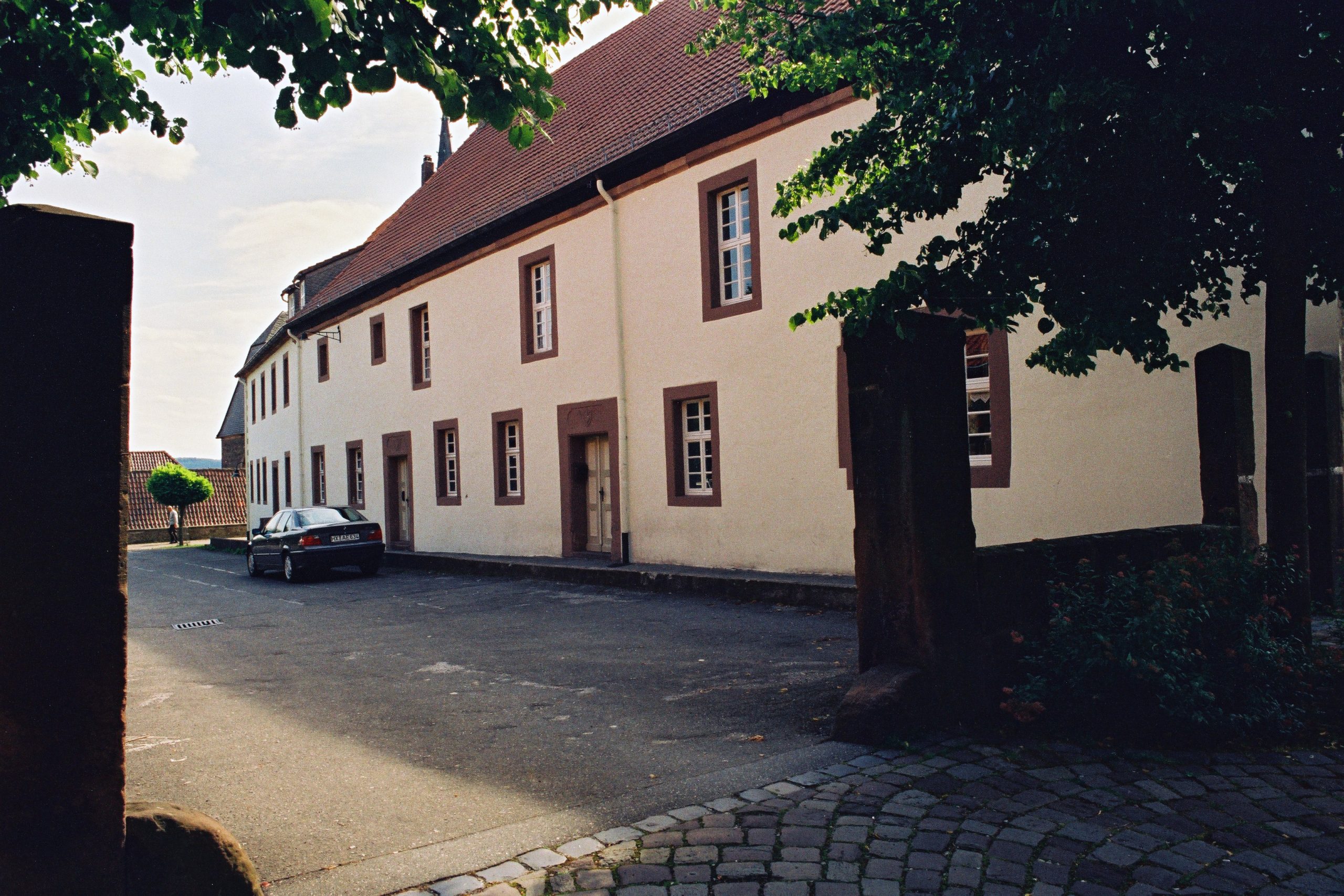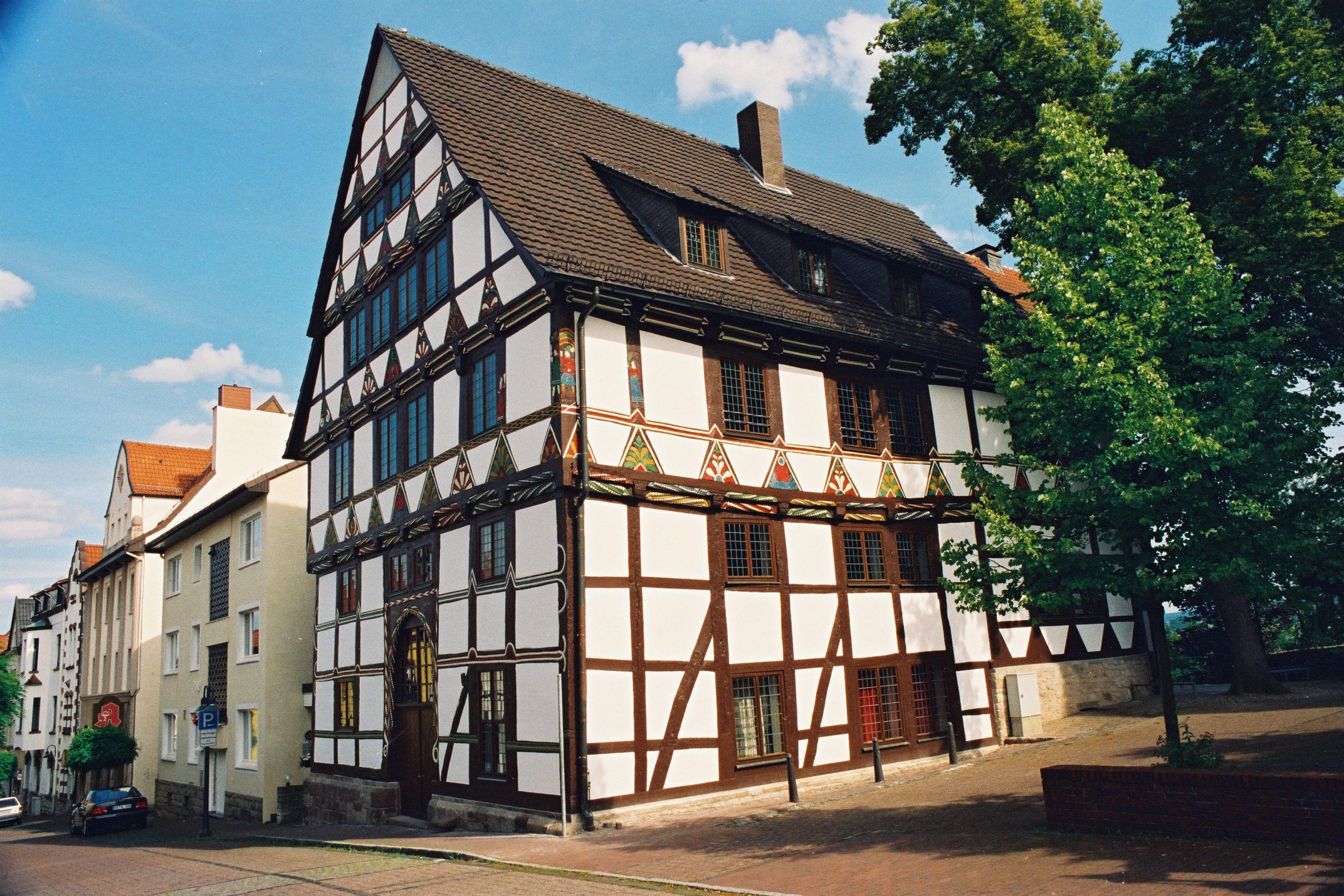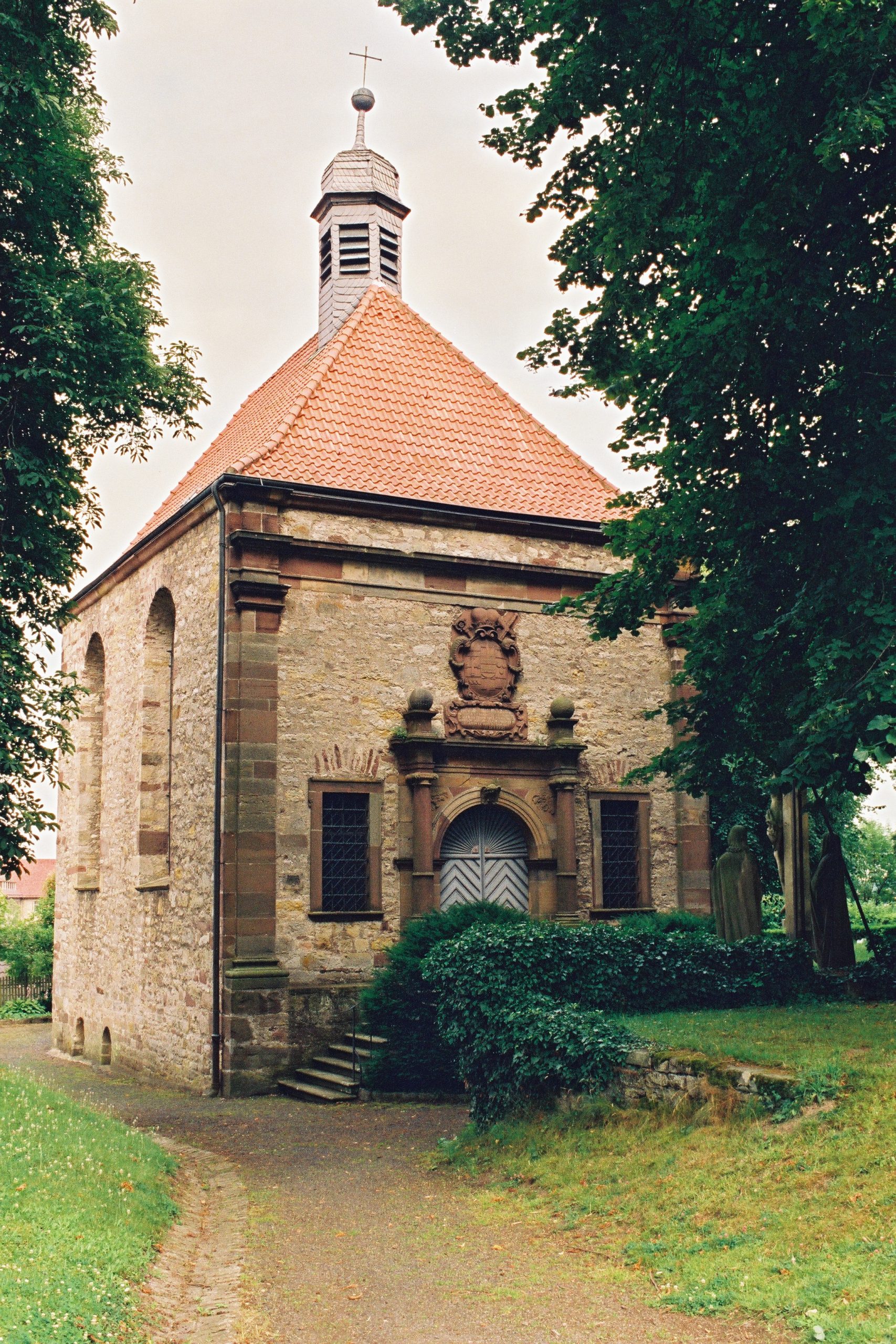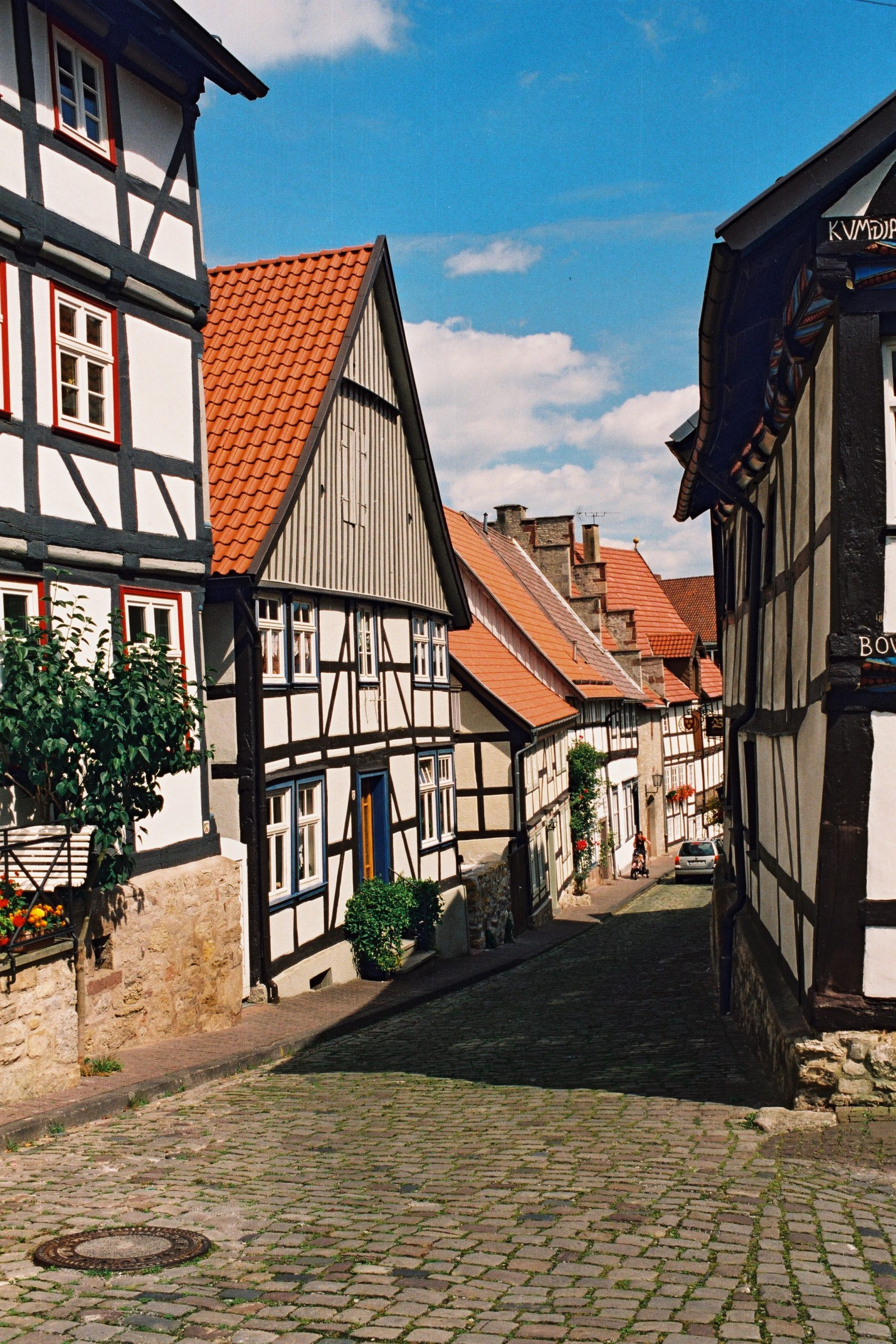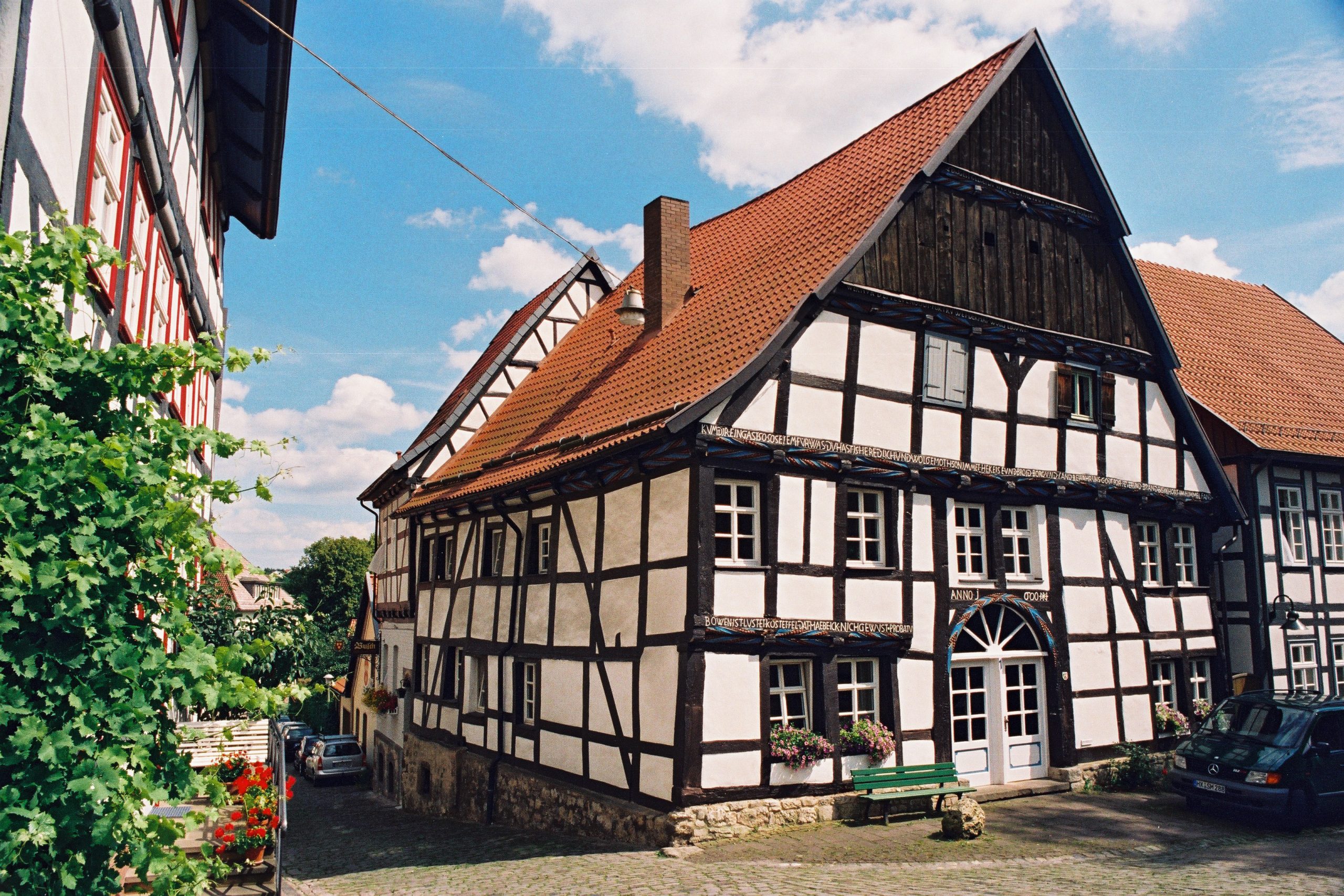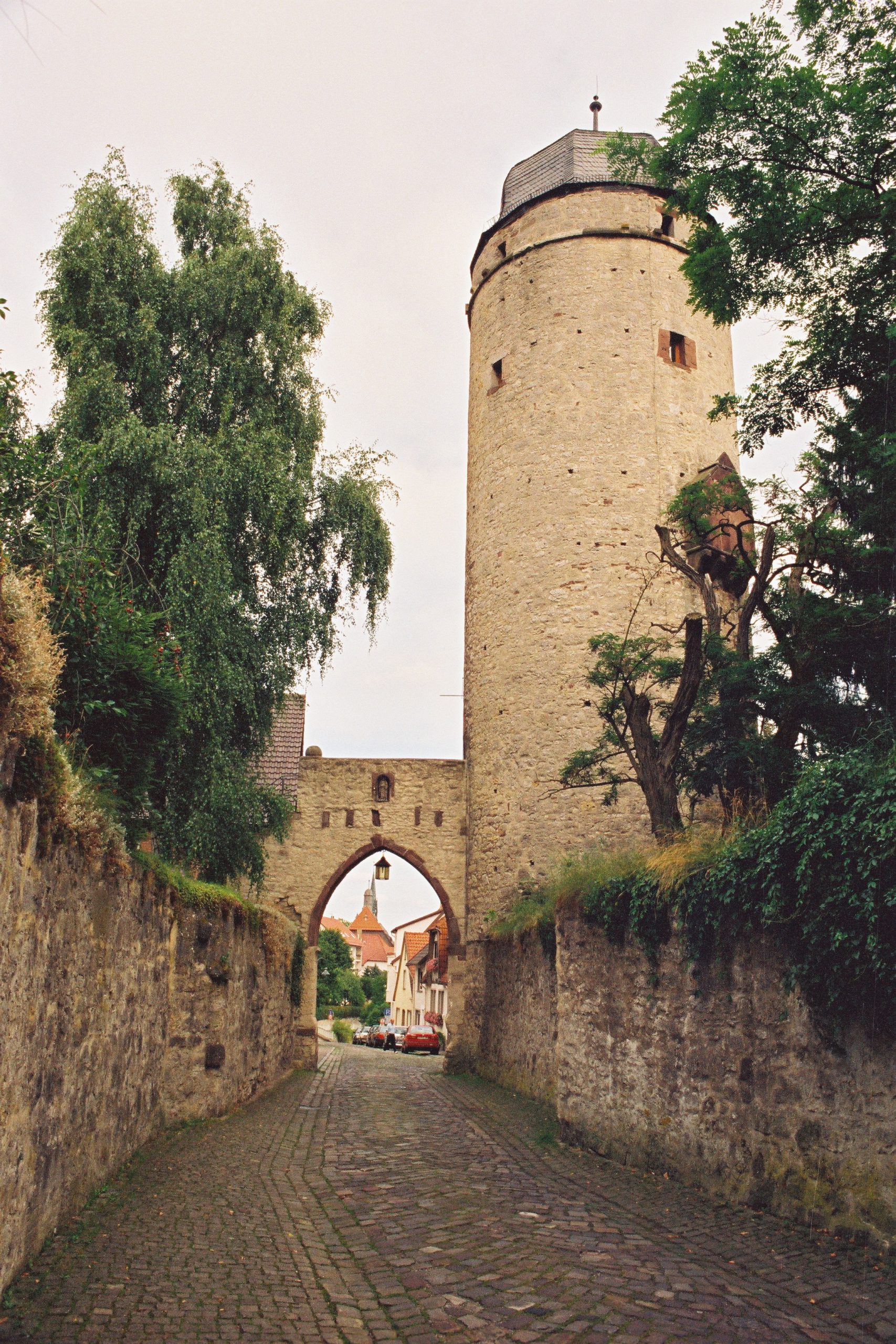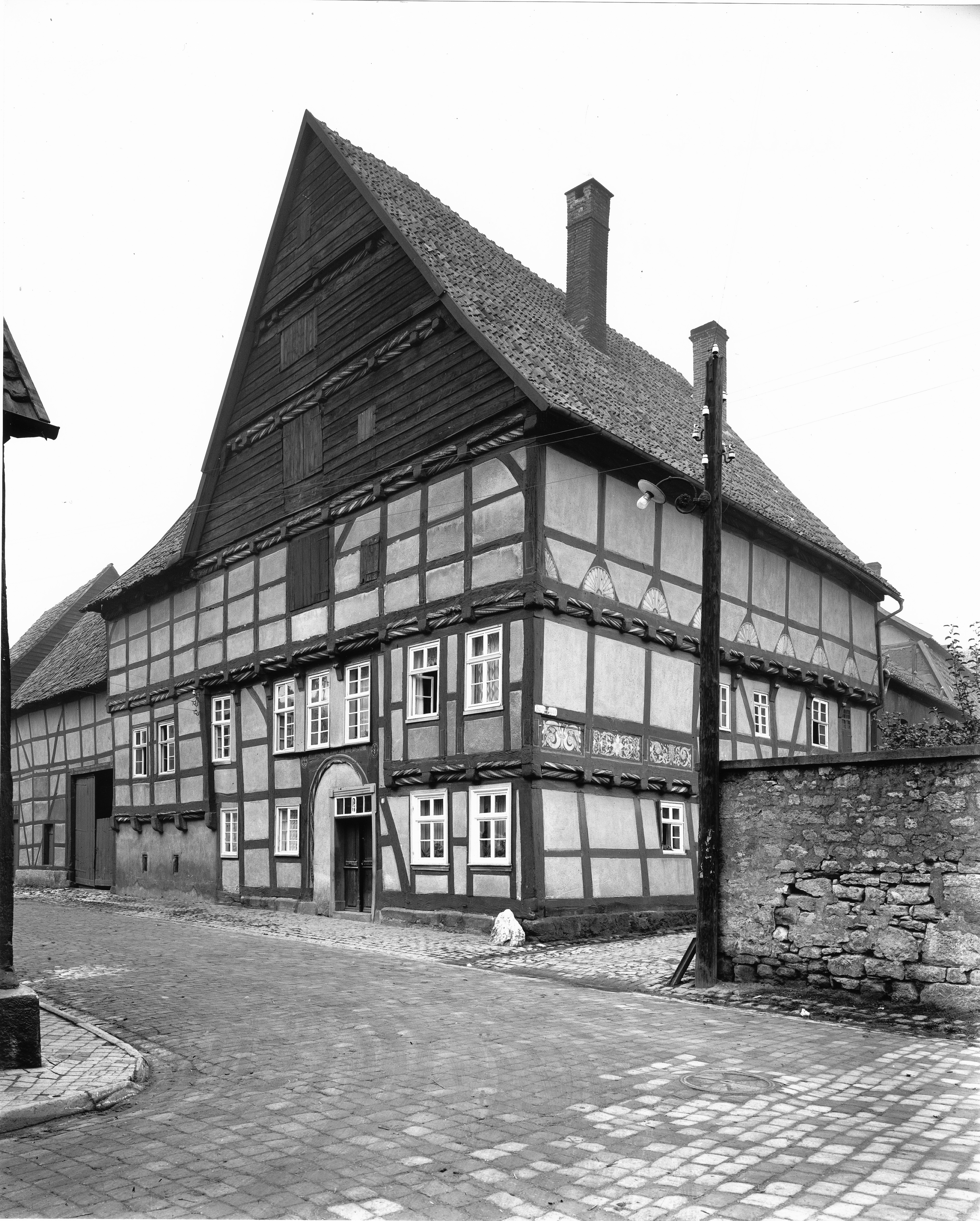Our ancestors from the old town of Warburg
The branch of the family Thönen/Tönnemann/Thonemann in the old town of Warburg began with Hermann I. de Tonne, Dean of the Wollweberzunft (wool weavers guild) in 1331 according to available documents. It can be seen in the "Contributions to Westphalian Family Research – Warburg genealogical tables of families of the town of Warburg” – prepared by Friedrich Joseph Liborius Heidenreich – that the town councillor family Thöne/Thonemann from 1330 to 1650 is documented with the Tönnemann branch to 1800.
Over a period of three centuries our direct ancestors lived in Warburg, until our founding father, due to a settlement with the monastery of Hardehausen (today belonging to Warburg), for a big loan took a new property in Scherfede (today also belonging to Warburg) and settled there.
As already mentioned, Hermann de Tonne was the first great-grandfather / ancestor of the Thonemann family from Warburg. It can be seen from an old certificate that Hermann de Tonne was at the head of the Warburg wool weavers who came to an agreement with the Willebadessen monastery concerning a mill near Warburg on 2nd February 1331. The certificate bearing the seal of the council of the old town of Warburg was signed by five wool weavers at whose head was Hermann de Tonne, and of great importance because the occupation of our forefather at the time is provided. The wool weavers guild in Warburg was a reputable guild whose products “the good Warburg cloth” went in extensive trade relations far beyond the town into the Paderborn area.
In the old town of Warburg the main street, die Wollweberstrasse, was called after this guild. The Thöne family lived on this street as can be seen from a certificate of 1456. Hermann I was born in Warburg about 1275; he got married in 1300 – the name of his wife is not known – and had two sons: Cord and Hermann.
Hardehauser Mönchshof in Warburg, Sternstraße 27, built 1291 – 45,65 m long and 13,30 m wide.
Cord I. (Conrad) Tonne, is in the line of ancestors of the next generation; born about 1300. In 1320 he got married and was named eleven times in the council of the old town from 1337 to 1359. Details of the council activities of his brother Hermann from 1330 to 1360 are available. It is reported that Cord died on 26th January 1359.
Johann I., is the next forefather in the series. He was the son of Cord I and was born in 1322. He married a woman called Regenheydis. The name was witnessed in a certificate of Wormeln monastery from 27th December 1348. Here it is stated that Bartholdus de Ringelsen pledged to the citizen of the old town of Warburg Johannes, called Tonne, his wife Regenheydis and her heirs for 60 Warburg shillings and four "Malter” of wheat two acres of land (1 acre = 0,25 ha) at Schloss Calenberg. On 27th March 1347 "Johannes Filius Conradi Tonnen” as Consol signed a deed of donation of Conrad de Ekhosen.
Johannes’s brother, Hermann II, born 1321, attested as councillor from 1353 to 1360 and Heinrich I, born 1325, are listed as citizens of the old town in 1371. In 1378 Heinrich is listed among the councillors of the old town. He died in 1381. On 31st March 1400 Mette, the legitimate daughter of the “long-dead Henrik”, with the agreement of her husband Heinrich Smedes, sold eight acres of land to the monastery of Wormeln. As no other kin are mentioned in this sale, it is supposed that she was Heinrich’s only child.
Johann II. called Thonemann, was the next in line. In 1421 he signed the guild letter of the butchers’ guild with the name "Hans Thonemann weaver”. He was a son of Johann and Regenheydis and had two sons, one was named like the father: Johann, the second Cord, like the great-grandfather. Johann II was born in 1350; the wedding date and the wife’s name are not known.
Johann III. followed in the family line. While this line is fixed the dates of birth of Johann and his brother Cord are not known; it must have been about 1400. According to a certificate of 19th December 1456 (Paderborner Altertumsverein (Antiquity club)) Johann, called Hans, lived on Wullenweberstrasse beside the municipal dyeworks near Berner and Badstovertor. In this certificate from 19th December 1456 Hans Thonen was called a "Rame”, i.e. weaver. According to a town register of 1460 he had four farm-labourers and a farm-girl. He must have been a wealthy man because he set up one of the biggest endowments for the poor of the town of Warburg, the "Hans-Thonemann-Stiftung”. Every year at St. Nikolaus from this endowment, nine poor men and nine poor women each received a pair of "double lined shoes”, a further 80 to 85 poor people of the city linen, "four poor people” on the Wednesday before Christmas every year "five yards of material” for the production of clothes.
The considerable wealth of this ancestor, Hans Thonemann, is also shown by another certificate: in the Warburg tax books for this time he is listed among the first taxpayers of the town. In 1460 he paid 8 shillings and 12 pence Schott (property tax), from 1464 even 14 shillings (“solid”).
Unfortunately the name of Hans Thonemann’s wife is not known; she was probably the daughter of Hans Lovelmann, the great wholesaler and councillor of the old town ( councillor 1436 to 1457). This can be seen from the following recorded fact: at the time the city owned a big meadowland near Asseln, which it gave to its citizens on leasehold for permanent use.
The leasehold sites were passed from the parents on to the children (today comparable “Erbbaurecht – law of succession”), the title to ownership remained with the town of Warburg. In 1464 the Wiesengeldregister for Asseln contains a remark with the following statement:
“Item de Thone hebt de Wese, de Hans Lovelmann hadde, vor 1 Mark.”
From this it can be concluded that the Lovelmann meadow had been inherited by the Thöne family, i.e. Hans Thonen had the inheriting daughter of the Lovelmanns as wife. According to a guild letter of 1436 Hans was a member of the reputable guild of wholesalers.
In 1479 Hans Thonen / Thonemann was named for the last time in the tax lists of the old town of Warburg. Hans Thonen / Thonemann’s brother, Cord Thonen, was listed in the council records of Warburg at the same time as Hans Thonen. The name Cord was already seen in the case of the great-grandfather. In 1460 the town of Warburg provided 307 soldiers, 43 of them mounted, Cord Thonen was also among them.
The direct line of the male ancestors of the Thonemann family in the old town of Warburg continued with Cord III Thöne ; he was born in 1430, his brother Ditmar in 1435, and Johann in 1438. They were all called sons of the wool weaver Thone – or also Thonen: Hans Thonemann and his wife N. Lovelmann; from the father the big "Hans Thonemann endowment for the poor” is known. The mother Lovelmann was descended from the noble von Lovene family, who were ministers of low rank with the Graf von Everstein and the bishops of Paderborn, at about 1200. Later they also belonged to the families of Paderborn entitled to join the council. In the course of the years the line in Warburg changed their name to Lovenemann and Lovelmann. They were councillors of the town of Warburg for several years. Marriages were concluded with many old Warburg families. In the middle of the 16th Century the family in Warburg died out.
It is recorded that Cord III Thone(n) served in the war in 1464; from 1460 to 1478 he was registered in the tax lists as a citizen of the old town; further details concerning him are not known. He is not listed in the council records of those years. The Warburg genealogical tables state that again in 1527 a Thonemann (Johann V Heinrich) was active on the town council.
In 1455 Cord’s brother Johann IV was enrolled as a student of theology at Erfurt high school; his studies ran without interruption to the theology exams. He must have been the first academic of the family Thone / Thonemann. Later Johann became a clergyman in his hometown Warburg and in 1472 and 1515 was registered as chamberlain of the “Kaland” in Warburg. (Kaland = spiritual brotherhood of clergymen, later also of laymen, for attention to charity and for the care of dead members; Kaland brotherhoods succeeded in becoming rich in some towns which later led to decline; in the time of the Reformation this Kaland brotherhood disappeared).
Cord’s brother Ditmar was listed only once, in 1464, in the “Schott” books of the old town of Warburg; it is unknown if he moved away or died young.
“Haus Böttrich” in Warburg, Sternstraße 13. In the facade the very strong wood engravings – up to 40 cm wide – catch the eye. Inside the curved staircase is worth seeing.
Johann V. Heinrich Thone called Thonemann, was the next representative of the direct line of ancestors; he was born a son of Cord III about 1465. In 1527 his identity was documented as a representative of the council of the old town of Warburg. It is known that he was married twice. The name of the first wife – possibly the first name was Anna – is not known; the couple got married between 1496 and 1499.
Johann Heinrich Thone / Thonemann’s second wife was Metta Gerold, daughter of Martin Gerold, the mayor, and his wife Anna von Geismar; the marriage was concluded about 1500. Through her the name Martin came into the Thonemann family. In the case of the name Gerold it is a Warburg family which can be seen from 1440 to today (Dr. Heidenreich in “Warburger Stammtafeln – Genealogien von Geschlechtern der Stadt Warburg”). The family name derives from a first name so that it is no surprise that in many places in the surroundings of Warburg there are families of the same name. In 1527 Mayor Martin Gerold, Johann III’s only son and his son in his minority were invested with various properties in the Warburg area.
The Warburg von Geismar family was named after Hofgeismar (a district in Hesse), as opposed to the von Geismar family named after Geismar near Göttingen and von Geismar after Geismar near Fritzlar. The von Geismars in Warburg were originally ministers who succeeded into the patrician class of Warburg by marriage but kept membership of the landed gentry. Great personalities came from this famous family in Warburg, e.g. Mayor Johann von Geismar – Heinrich von Geismar, 1412 Rector Magnifikus in Erfurt and co-founder of the University of Rostock, Abbot Albert von Geismar 1430 to 1449 in Hardehausen, Wilhelm-Otto von Geismar 1644, Marshall of the ruler of Fürstenberg, Justus Moritz von Geismar 1645, University Professor in Prague and Böhmischer Vice Chancellor, Christoph Gottfried von Geismar, 1662 Reichskammer junior barrister in Wetzlar, the Russian General Kasper von Geismar, died 1854; with him the family died out in Westphalia.
Johann V Heinrich had a sister Katharina – no other details are known – and a brother Cord IV (Conrad) Thone, also Thöne.
After her husband’s death in 1536, Metta Thonemann was among the first taxpayers in the old town of Warburg; she paid ten shillings Schott (property tax) and four shillings duty (rates = duty). The average citizen paid 1-2 shillings tax and duty; even three shillings was rare. Only two rich councillors (von Gyr and Beckmann) paid ten shillings; the Mayor, Dietrich von Geismar paid “only” two shillings.
Johann Heinrich Thone / Thöne had three sons and a daughter, from the first marriage the son Joist I Thöne, born about 1500, from the second marriage to Metta Gerold the son Martin Thöne, called Thonemann, who later became Abbot of the monastery in Hardehausen, the daughter Else Thöne, who probably remained unmarried and died in 1572, and the son Johann Thöne (Johann VI)
The direct line continued with Joist I Thone/Thöne. He was also called Thonemann. He was born in Warburg around 1500 – the exact date is not known – he was later a councillor and chamberlain of the old town in the time from 1535 to 1562. He died in 1572.
In the first marriage Joist married a Drudeken (Gertrud) probably from the Nabercord family, as in 1548 Ulrich and Dietrich Nabercord named Joist Thonemann, who had lent them 250 Taler, their uncle. In the second marriage. Joist was married to Angela von Listingen; she was the widow of the councillor Hermann Volmar, according to the marriage contract from Sonntag Quasi modo geniti of 1556. The marriage contract of Joist and Angela von Listingen of 1556 is also signed by the Nabercord family, what makes the probability of the first marriage with Drudeken Nabercord become more definite, the more so as the mayor, Johann Nabercord, the brother of Ulrich and Dietrich, was drawn in as arbitrator beside other relatives in the settlement between the Thone/Thonemann brothers and monastery of Hardehausen.
The Nabercords were a patrician council family in Warburg. From 1375 to 1600 they were rich and esteemed personages, who several times held the office of mayor or were councillors and chamberlains of the town. The family were closely related to all patrician families of the town. The first of this name in Warburg was Cord I Nabercord 1376, head of the brotherhood “Unsere Lieben Frau” (Our Dear Wife).
His wife was the daughter of Albrecht Radboden and Kinne von Geismar. The father-in-law, Hermann von Dössel, established an altar benefit in Warburg Neustadt, which his grandson Hermann I Nabercord claimed. The latter was a student in Cologne and Erfurt from 1422 and got his doctorate Dr. jur. et decretorum, then became Rector of the Universtiy of Cologne. The last report about this family noted that in 1601 Ulrich IV sold his house in Hundegasse in Warburg to his brother-in-law Bernhard von Geismar.
Also the von Listingen family, called after the place of the same name near Warburg, were an old patrician family in Warburg, originally ministers of the monasteries Bredelar and Wormeln and of the nobility von Oesede and von Gudensberg. They provided numerous mayors in Warburg, starting with Johann von Listingen 1295 to 1314, who was mayor of the old town in 1309. Also Angela’s father Bernhard and grandfather Hermann and her brother Hermann also held this honorary office in Warburg.
Erasmuskapelle (chapel) – also called Burgkapelle – built on the castle graveyard, previously the location of the castle church of St. Andreas. Particularly worthy of note is the crypt, one of the oldest constructions, and a landmark of the town in art-historical terms.
Joist Thöne/Thonemann lived in the family home in Wullenweberstrasse, which he inherited. His daughters from the first marriage with Gertrud Nabercord, Goda Thöne, Anna Thöne and Gertrud Thöne married into reputable senatorial families. From his sons out of the second marriage with Angela von Listingen, Johann, Christoph and Joachim, all councillors of the old town, the eldest (Johann VII Thöne) founded the generation in Scherfede.
He was characterised as founding father of the Scherfede Thonemann branch.
A certificate from 11th November 1542 showed Joist Thone as councillor; in the marriage certificate he bore the title chamberlain and was called such in 1559 again. Joist must have had a considerable property of his own. In 1548 he acquired from the brothers Ulrich and Dieter Nabercord four “Huben” of land, that is about 120 acres (about 30 ha) in Warburg-Molhausen. Mayor Georg von Geismar put his seal on the contract for this real estate deal. A last report, less welcome, was in the chronicle of Heinrich von Hiddessen, with the following remark: “In 1572 at 6 in the morning flax caught fire in Jost Thonemann’s house on Wullenweberstraße. First of all it only smouldered, but then it developed into a real fire. The fire bell was rung and with the help of neighbours the fire was quickly put out.”. Thus it is also recorded that Joist as the first-born had inherited the family home on Wullenweberstraße, which had previously been occupied by the father Johann V, the grandfather of Cord III and the great grandfather Hans Thonemann in 1456.
Joist’s daughter Anna married the neighbour Liborius Weddigen, a brother or cousin of the university professor at Marburg and Helmstedt Dr. of law Johann Weddigen.
Joist’s second daughter Goda was the wife of Baltasar Erdmann from a Warburg senatorial family.
Joist’s third daughter, Gertrud, married Cord Schlicker, councillor and chamberlain of the old town, and became the founding mother of the esteemed and rich mayoral Schlicker family in the old town of Warburg. They were goldsmiths by trade and dealt in gold- and silverware. It has been handed down that they regularly visited the Frankfurt Fair. Jodokus Schlicker, merchant and dealer in gold, built a beautiful big house on Langenstrasse, which passed into other hands in 1609 and still stands today.
The three sons of Joist I and Angela von Listingen, Johann VII, Christoph and Joachim were all councillors. Either Christoph or Joachim had a son, Georg, who founded the later Warburg lawyer family Thönemann/Tönnemann, who were ennobled in the 18th Century. (“Johann Vitus Christoph was ennobled by Kaiser Karl VI”).
Johann VI Thöne, the younger brother of Abbot Martin Thonemann of Hardehausen, was councillor of the old town of Warburg for years. In 1575 he was listed as chamberlain. In 1562 he built a new house on Wullenweberstrasse which later belonged to the Tegethoff family. An inscription was put on this house (according to the records of scholarships) with the following words: “Johann Thönen herus dominus AO 1562” (Johann Thönen, master of the house in 1562). He must have been a wealthy man – like his elder brother Joist Thöne. In 1572 he lent Friedrich von Papenheim a total of 200 gold guilders and on Trinity Sunday 1581 another 110 Reichstaler; von Papenheim called him the “honourable and noble” Johann Thönen. However the money still had not been paid back in 1621.
His first wife was Gertrud Volmar, the daughter of councillor Hermann Volmar and Angela von Listingen. She was the sister of Cord Volmar, the mayor, and of the Mainz University professor Paul Volmar and Heinrich Volmar. The privy councillor Dr. utriusque juris Heinrich Volmar was the last Provost at Fritzlar Cathedral; from 1570 he sat as privy councillor to the elector-archbishop Daniel Brender von Homburg in Mainz. At St. Peter’s he held the position of Dean. As university professor he read bible exegesis; in 1586 he wore the purple of Rector Magnifikus, a position his elder brother, the Mainz court judge, Dr. Paul Volmar had already held in 1556.
An indication of his wealth was the fact that Heinrich Volmar on his death in 1597 left his hometown Warburg 1000 gold guilders as a scholarship for young students which later passed on to Heinrich Thonemann. It was stated in his obituary: “Magna Vir et prudentia et virtatis laude”, a very famous man due to his sagacity and proficiency.
After the death of Gertrud (née Volmar) his first wife, Johann VI Thöne married Anna von Steinheim, a patrician daughter, in 1570. He died on Good Friday 1588. Heinrich, the well-known founder of Warburg grammar school, was a son of the first marriage. Born in 1566, he studied at the universities of Mainz and Cologne and did his doctorate in 1585 in the fine arts. (Heinrich Thöne).
Heinrich’s brother Martin came from the second marriage of his father Johann VI to Anna von Steinheim. In keeping with family tradition he was a councillor, chamberlain and a wine-grower and in 1616 also mayor of the old town of Warburg. He lived in a big house on Altstädter Markt, that he had taken over (by marriage) in 1596 as a result of his marriage to Anna von Reußen, an inheriting daughter of the last mayor of this family, Johann von Reußen, and his wife Elisabeth von Höxter. After the early death of his first wife, Martin remarried. His second wife was Katharina von Geismar (see section on Geismar Family). The sister of Heinrich and Martin, Elisabeth, married Jost Schlicker from the rich senatorial family, whose members held the mayoralty in the new town of Warburg several times from 1614 (see also section on Schlicker family).
The first son from the second marriage of Joist and Angela von Listingen was Johann (Johann VII Thone/Thönen, called Thonemann). He was born in Warburg in 1557 and lived in the old town. In the time from 1586 to 1608 he was recorded as town councillor and chamberlain in the town registers of Warburg.
A view of one of the many picturesque lanes in the old town of Warburg.
Two of his other brothers, Christoph and Joachim, came from this marriage. While the family home remained in Warburg, Johann saw to it that the settlement with the monastery at Hardehausen was taken in hand for the big sum of money Metta, the mother, after her husband’s death had lent to the son Martin, Abbot of Hardehausen. The amount of the debt, which was lent in several instalments to maintain the big business and to pay off the debt, was in the currency of 1994 between DM 600,000 and DM 700,000 (EUR 300,000 to EUR 350,000).
During the lifetime of Abbot Martin Thonemann a final arrangement and subsequent settlement were not reached; it can be presumed that Abbot Martin died suddenly. As is known from old documents he was very fond of his brothers Joist I and Johann VI If Else, the sister was not mentioned, it is not due to Martin’s personal attitude to his sister but to the general spirit of the times which did not apportion the rank and dignity, also the importance and regard befitting the woman.
A two-storey half-timbered house at Josef-Kohlschein-Str. 1, built in 1600. It served as a stop for changing horses, for paid tasks and as an inn.
Until the payment of the debts of Abbot Martin Thonemann or rather of Hardehausen monastery to the lender Metta Thonemann or rather the Thonemann family could be made, many years passed; this time was to be sure not without tension between the monastery and the Thonemann family, as the monastery had not approved the contract of 1568. Only shortly before the death of Joist I (died 1572) and Else (died 1572) was it possible to conclude a settlement together with Johann VI (the three representatives of the Thonemann family) – still five years after the death of Abbot Martin, according to which the family were mostly able to keep the property allotted to them. Joist I, Johann VI and Else were present at the conclusion of the contract of settlement. The contents of the contract are not known. It will have been in the issue of rights to sites from the ownership of the monastery in Scherfede. From the Warburg sources and documents, also the tax register, Johann VII disappeared without offspring in Warburg.
Johann VII had two brothers, Christoph and Joachim, both of whom were councillors in Warburg, as was Johann too. (Johann, councillor and chamberlain from 1588 to 1608; Christoph, councillor from 1589 to 1597; Joachim, councillor from 1599 to 1600).
Johann VII is regarded as the founding father of the Thonemann branch in Scherfede. He mostly fashioned the regulations in Scherfede, but kept his house in Warburg and continued to carry out his councillor duties there. It is not known whom or when he married, presumably around 1580.
According to the files of the administration of the district President in Dringenberg for 1605 both of his sons Johann VIII Thonemann and Cord Thonemann were registered as residents in Scherfede. Johann VIII was born between 1580 and 1583, Cord about 1585.
Thus the Thonemann branch in Warburg ends. It stretched over ten generations from 1275 to 1608 – a period of 333 years – and was described here.
The New Town Thöne family
The Thöne/Thönen/Thonemann family was not only represented in the old town of Warburg, but also in later years in the new town of Warburg. Without a doubt they branched off from the older old town Thöne / Thonemann family. This is shown by documents concerning public happenings and tasks, council activities in the new town and also identical Christian names such as Johann, Heinrich, Cord and Hermann. One also comes across the pet name “Thönemann/Thonemann”.
The first Thone / Thonemann recorded by name in the new town is Cord I(I) Thone(n); he was the brother of the senator of the old town Johann III Thone, called Hans Thonemann, well-known by the foundation of the endowment for the poor “Hans-Thonemann-Stiftung”. His father was Johann II, who as councillor of the old town certified the guild letter of the butchers’ guild in 1421. Cord I settled in Busdorf, a district or rather a group of farmers of the new town. He was recorded there as the first bearer of the name as he was elected in 1440 and 1442 as councillor of the new town. Cord’s date of birth – as well as that of Johann II his brother – is not known. It must have been between 1400 and 1410. He died in 1473 or later as he was still mentioned in that year.
The Warburg town archives has a list from 1464 of the mobilised army, the so-called “Perdbok”. From this book, set up on account of the war between Paderborn and Hesse, can be seen that the town of Warburg had to raise a troop of 307 armed men, 43 of them mounted. A Cord Thonen was among the mounted citizens, while the “wool weaver Hans Thonen from the old town” was a foot soldier with a crossbow.
From a decree of the council of Warburg of 1438, can be read that this official and civic duty was a serious matter and was not to be compared with that of a leisurely city soldier. There it was said: “if it happened that any of our citizens or their workers fled the banner or the troop, Heaven forbid, his body and possessions are to stand in the hands of the towns like one of our enemies.”
Some years later, in 1442, this civic army proved their strength as Herzog Erich von Braunschweig-Grubenhagen, with 300 riders and loaded with rich booty from a plundering raid into Paderborn Land wanted to go home, were challenged in woodland in Solling, surrounded and brought in safe custody to Warburg where the prisoners were held up to five years until the ransom was paid. The fortified “Sackturm” in Warburg was built which is still a credit to the town today.
Sackturm – fortified tower at the inside gate with a fortified way – built in 1443 – today still a symbol of the town’s ability to defend itself. Inside the tower a memorial was erected for the victims of war.
Cord Thone lived in the Busdorf/Neustadt district; his eldest son, Hermann I lived there too with his wife and one son Heinrich I (1473 to 1507) and a daughter, whose name is not known, mentioned in the tax lists of Neustadt (Schottbuch) with a tax payment of three shillings. Keep in mind that 14 shillings was demanded of Johann Thone in the old town. Cord I’s second son was Johann I (1464) who also lived in Busdorf/Neustadt. He had three sons: Cord II (1473 to 1517), Hermann II (1474 to 1530) and Volmar (1464 to 1479); all three were also called “Tonemann”.
Cord II (1473 to 1517) was probably Johann’s eldest son. With Cord – named after the grandfather Cord I his family took over the continuation of the family line. Cord the grandson lived in Papenheim, a district of the new town of Warburg. Of him it is known that for the payment of twenty shillings a year, he had the right to brew beer for family consumption in the municipal beer pan used for roasting the hops. According to municipal documents he appeared in 1502 as a witness in court for his neighbour, Dedeke Tepelin, the smith.
The son of Cord II was called Johann Thune / Thone (councillor from 1523 to 1530); he married the daughter of mayor Heinrich Giseler (1478 to 1506); in this way the Christian name Giseler came subsequently into the new town family. In literature it is noted for this time that in Paderborner Land there was a peculiar habit of using the family name as the first name.
Johann II Thone (1503 to 1530) had three sons with N, née Giseler: Cord III (1518 to 1554), after the grandfather on the father’s side, Giseler I (1526 to 1566), after the grandfather on the mother’s side, and Heinrich (1523 to 1579), as the name was repeated in the family.
The eldest son, Cord, studied theology, became curate at the Neustädter Heimatkirche, later parson of Germete – close to Warburg – and some years later chamberlain and deacon of the Kaland brotherhood (1537). It can be seen from old documents that he, like the whole Kaland brotherhood, took a stand against the infiltration of Lutheran doctrine with all power. In 1550 during his reign Kaiser Karl V issued a letter of protection to the Kaland brotherhood concerning all rights, goods and privileges. His conservative attitude was also the reason for Cord Thone in 1544 to receive the call to vice archdeacon in the Warburg area and thus supervision of 23 parsons and the local monastery. Until his death on 14th June 1554 he defended himself in this time of strife against all deviating movements. He donated the altar and a benefit of annual interest from 17 talers and 18 silver ten-pfennig pieces, capital loaned by him of 105 talers and 50 Rhenish gold guilders of Neustädter Kirche.
Cord’s brother Giseler built a new house in the Molshausen district as from the papers the payment of real estate tax and tax from agricultural properties can be seen. He was probably a farmer. In 1559 he was a councillor of the new town and was charged with the examination and supervision of bakeries.
Heinrich, his younger brother, was also a councillor of the new town. Thereby it is interesting to note that the new town Thöne/Thönen families used the surname Thonemann.
The son of Heinrich II was also a councillor, and was called Jost II (as opposed to the father Jost I Senior in Papenheim). He built a three-storey half-timber house on Mittelstrasse overlooking Rotthof.
Jost II Thone – called Thonemann – built this three-storey, half-timber house in 1578 in Warburg. For many years it was a gem in Warburg on the Rotthof – burnt down during the war in April 1945. Museum Warburg (photo).
It was built in 1578 and was a gem of the city for many years. In April 1945 the house was burnt down completely in the fighting of the Second World War, as the fire brigade could not be sent in due to the fighting taking place there at the time. Today (1994) a building of the sickness insurance (AOK) is at Josef-Wirmer-Strasse 28 (previously Mittelstrasse 28). Josef Wirmer was the son of headmaster Wirmer at Marianum grammar school. He was killed in connection with the attempted assassination of Adolf Hitler on 20th July 1944.
Giseler I had five sons: Kaspar I and Christoph studied in Marburg, Jost I Senior was a councillor in Papenheim / Neustadt, Urban, councillor from 1552 to 1581, died 1585, lived in the district of Busdorf, later in Molshausen, his offspring moved from Warburg; after his death it was not possible to contact the heirs living outside, as can be seen from a municipal note. Cord IV was the youngest son, councillor from 1575, lived like his father Giseler I in Molshausen; he had two sons, Johann and Jost, and died in 1581.
Jost I Senior (1552 to 1588), councillor of Papenheim, had two sons:
Kaspar II (1581 to 1599), and Joachim (1578 to 1612). Kaspar married Katharina Brendeken. The couple had no children. The brother Jost IV – mostly called Joachim – was married twice, in the first marriage to Elsa Beckmann, his second wife’s surname was Nordermann, Christian name unknown (1599). From 1599 he was councillor and in 1610 with Martin Thöne from the old town held the office of town treasurer. He worked as a notary in Warburg. In 1600 together with Jost III he was representative of the town in brewery matters. The Elsa Beckmann already mentioned came from the Beckmann family who provided four members as parson of Neustädter Kirche from 1509 to 1565. Among them was Otto Beckmann who, after his studies in Holland, that brought him together with Erasmus of Rotterdam, worked as professor of theology in Wittenberg; there he became a friend of Martin Luther. He is supposed to have worked on the drafting of Luther’s theses. However he split with the reformer, gave up his Chair in Wittenberg, returned to his hometown Warburg and as the parson of the Neustädter Kirche “protected” his “sheep” from the “false doctrines” of the Reformation.
In 1629 Jost V took over the mayoralty which represented a difficult burden in the turmoil of the war years, that he administered in a good relationship to his citizens until his death in 1652. In 1633 Heidenreich von Calenberg, the general from Hesse, took him and Mayor Bernd Ortwein hostage to Kassel and kept them under arrest for five weeks. In the following year Mayor Jost Thöne / Thonemann was brought to Paderborn as a prisoner of Graf von Oberstein.
Two years later he was again imprisoned in Paderborn. He was brought by the Swedes with Mayor Jost Nolten to Kassel and locked up in a tower for a period of three weeks. It is recorded that the town of Warburg had to pay 135 talers for three weeks alone “for catering and accommodation” of their two mayors.
Jost Thone died at the age of 75. In the same year a daughter, Anna Elisabeth, had been born. His death ended the family line in Warburg. All members of the family had either died or left the town.
One last point is that in his first marriage Jost V Thone/Thonemann was married to Elisabeth Erdmann in 1604. The three children of this marriage died young. In his second marriage during his captivity in Kassel he married a local widow whose name is unknown. The couple had no children. In 1640 she died in Warburg. At a late age he married for the third time, his ward Elisabeth von Hiddessen. Her father was general under Tilly. He was later imperial governor of Emsland and commanding officer in Meppen.
